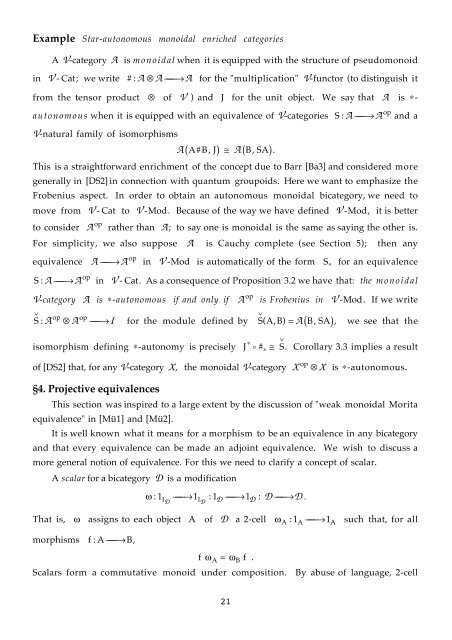Frobenius monads and pseudomonoids Introduction - ResearchGate
Frobenius monads and pseudomonoids Introduction - ResearchGate
Frobenius monads and pseudomonoids Introduction - ResearchGate
Create successful ePaper yourself
Turn your PDF publications into a flip-book with our unique Google optimized e-Paper software.
Example Star-autonomous monoidal enriched categories<br />
A V-category A is monoidal when it is equipped with the structure of pseudomonoid<br />
in V - Cat; we write<br />
#:A ƒA æ æÆA for the "multiplication" V-functor (to distinguish it<br />
from the tensor product ƒ of V ) <strong>and</strong> J for the unit object. We say that A is *-<br />
autonomous when it is equipped with an equivalence of V-categories S<br />
V-natural family of isomorphisms<br />
( ) @ ( ).<br />
A A# B, J A B, SA<br />
op<br />
: A æÆ æ A <strong>and</strong> a<br />
This is a straightforward enrichment of the concept due to Barr [Ba3] <strong>and</strong> considered more<br />
generally in [DS2] in connection with quantum groupoids. Here we want to emphasize the<br />
<strong>Frobenius</strong> aspect. In order to obtain an autonomous monoidal bicategory, we need to<br />
move from V - Cat to V -Mod. Because of the way we have defined V -Mod, it is better<br />
to consider<br />
A op rather than A; to say one is monoidal is the same as saying the other is.<br />
For simplicity, we also suppose A is Cauchy complete (see Section 5); then any<br />
equivalence<br />
S<br />
A æÆ æ Aop<br />
in V -Mod is automatically of the form S * for an equivalence<br />
op<br />
: A æÆ æ A in V - Cat. As a consequence of Proposition 3.2 we have that: the monoidal<br />
V-category A is *-autonomous if <strong>and</strong> only if A op is <strong>Frobenius</strong> in V -Mod. If we write<br />
⁄<br />
op op<br />
S : A ƒA æ æÆI<br />
for the module defined by<br />
isomorphism defining *-autonomy is precisely<br />
of [DS2] that, for any V-category X, the monoidal V-category<br />
§4. Projective equivalences<br />
*<br />
⁄<br />
SAB ( , ) A B, SA,<br />
we see that the<br />
= ( )<br />
J o # @ S.<br />
Corollary 3.3 implies a result<br />
*<br />
⁄<br />
op X ƒ X is *-autonomous.<br />
This section was inspired to a large extent by the discussion of "weak monoidal Morita<br />
equivalence" in [Mü1] <strong>and</strong> [Mü2].<br />
It is well known what it means for a morphism to be an equivalence in any bicategory<br />
<strong>and</strong> that every equivalence can be made an adjoint equivalence. We wish to discuss a<br />
more general notion of equivalence. For this we need to clarify a concept of scalar.<br />
A scalar for a bicategory D is a modification<br />
w : 11 æÆ æ 11 : 1 1 :<br />
D D D æ æÆ D D æ ÆD<br />
.<br />
That is, w assigns to each object A of D a 2-cell w A A A<br />
morphisms f: A æÆ æ B,<br />
:1 æÆ æ 1 such that, for all<br />
f wA = wB<br />
f .<br />
Scalars form a commutative monoid under composition. By abuse of language, 2-cell<br />
21
















